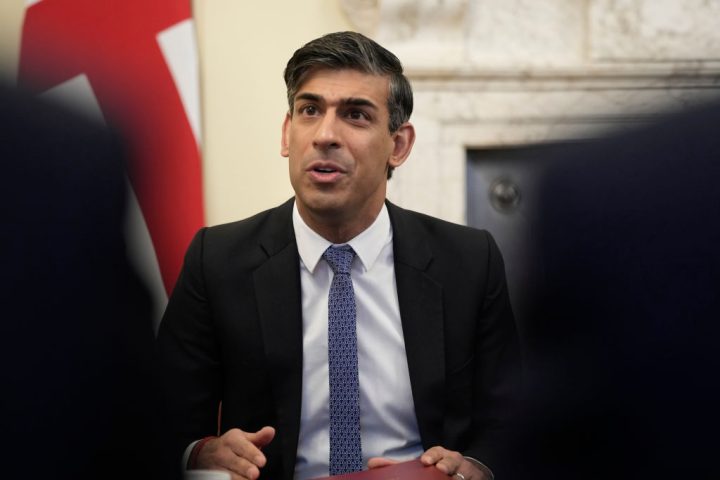Inflation has slowed significantly, according to the latest update from the Office for National Statistics. The headline rate was 4.6 per cent in the year to October, down from 6.7 per cent the previous month. The sharp slowdown is largely attributed to last year’s hikes in energy prices dropping out of the data with the figures now reflecting Ofgem’s price cap reduction.
This major slowdown in the inflation rate allows Rishi Sunak and Jeremy Hunt to say that one of their five pledges for the year has been delivered.
In January, the prime minister promised to ‘halve inflation’ by the end of the year. The rate in January was 10.1 per cent on the year, so he and the chancellor needed to see the rate slow to roughly 5 per cent – still more than double the Bank of England’s target of 2 per cent, but far below the double digit inflation rate Britain had been enduring at the end of last year.
Today’s Consumer Price Index number comes in just below consensus (which stood at 4.8 per cent). While it’s possible the rate will fluctuate back up in the coming months, it suggests that the government will be able to say this December that the inflation rate has been ‘halved’ as promised.
How much credit can – and should – the government take for this achievement? Growth is stagnant, debt and the NHS wait lists are rising and thousands continue to arrive on small boats (a pledge we’ll hear a lot more about later this morning, when the Supreme Court’s decision on the Rwanda policy is unveiled). Given these other four priorities aren’t going quite to plan, it is rather unsurprising that ministers want to boast.
Sunak is reminding people that ‘in January, I made halving inflation this year my top priority…today, we have delivered on that pledge’. Various government accounts, including the Treasury, are promoting that they have halved inflation.
In January we said we’d halve inflation.
— HM Treasury (@hmtreasury) November 15, 2023
Today we’ve done that – inflation is now 4.6%.
Why does that matter?
Because it means people keeping more of what they earn, letting them provide for their families, do the things they love & invest in their futures. pic.twitter.com/FXJOjrZgvc
It is Hunt’s view that the government did play a meaningful role in slowing the rate, mainly due to fiscal prudence more than any kind of direct action. The decision not to go for bigger pay rises for the public sector – including for the NHS – and to resist the urge to splash cash (in the form of giveaways or tax cuts) has been crucial, he thinks, to the fight against inflation.
He has a point. After several years of limitless spending, it took more effort than usual to take some heat out of the economy, not least with all the political pressures to keep offering up subsidies (including the calls to assist people with their mortgages).
How much credit can – and should – the government take for this achievement?
The vast bulk of the work, however, came from the 14 consecutive interest rate hikes implemented by the Bank of England. Politicians did not control this process: instead they had to stand back and watch as the Bank moved at often quite slow speeds to raise rates and tackle inflation.
This is not the only reason the government might want to hold back from taking huge amounts of credit for today’s figures. Prices are still rising substantially and are set to do so, above the Bank’s target, until well into 2025. In other words, the rate of inflation is falling, but everyone is still worse off.
But today’s update does make it far more likely that we have reached the peak of interest rate hikes, which currently sit at 5.25 per cent. While the Bank isn’t back to its inflation target, the impact of some of those rate hikes still haven’t fed through to consumers. Already worried about tipping the UK economy into recession, the Monetary Policy Committee is more likely to hold rates now (so no rises or cuts) and watch as what’s already been done takes root.
None of this means there aren’t still worrying trends in the data: core inflation (which excludes more volatile prices like energy and food) remains stubbornly high, at 5.7 per cent on the year in October, down from 6.1 per cent in September.
This suggests that many of the price hikes experienced over the past two years have become baked into the system. This helps explain why it’s expected to take the Bank so long to get back down to target. Meanwhile the UK’s inflation rate is still rather ugly compared to its peers: in the Eurozone the inflation rate was down to 2.9 per cent on the year in October, while in the US it sits at 3.2 per cent.
Still, this morning’s update is undoubtedly good news for the government. As ministers approach the end of the year with the majority of the pledges looking dicey at best, when asked about achievements they will at least be able to say inflation has halved. Of course that’s slightly different from asking whether inflation has slowed enough, or whether it was really the government’s doing.







Comments